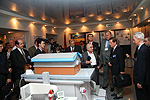Explosives detection and lightweight armour: update on two NATO Science for Peace projects
Eight members of the North Atlantic Council, NATO’s principal decision-making body, visited the Institute for Single Crystals at the National Academy of Science in Kharkiv, Ukraine on 17 June 2008 to find out more about two NATO Science for Peace projects underway there.
Under the framework of the NATO-Ukraine partnership scientists from Ukraine are collaborating with their counterparts from France and the United States to develop a new generation of multi-energy x-ray scanners to detect solid and liquid explosives with a probability of up to 90-95%. The project which is due to be completed in 2010, could lead to substantial improvements in the detection of illegal and dangerous objects and materials, assisting NATO member and partner countries with anti-terrorist inspection.
For the second project launched in 2006, expert teams from the Slovak Republic, the Czech Republic, Russia and Ukraine are working to develop a new generation of lightweight and transparent armour to be used to protect military vehicles. Currently the minimum thickness of transparent protection is between 80-120 mm making it too heavy for use in mobile devices. The new armour will be thinner and lighter while still providing the same level of protection.
These two projects illustrate the contribution of the NATO Science for Peace and Security programme to security and stability in the Euro-Atlantic zone which it achieves through joint cooperative research and development amongst scientists and experts from NATO countries, Ukraine and Russia.
